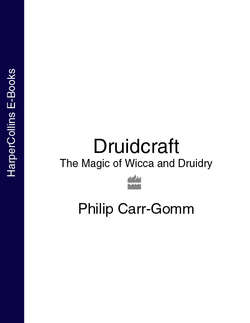Читать книгу Druidcraft: The Magic of Wicca and Druidry - Philip Carr-Gomm - Страница 10
The World of the Druid
ОглавлениеWhile the Cunning Folk worked alone or in small groups, and were the local wise people and healers in rural communities, the Druids were an organized elite, exempt from warfare and paying taxes, and they acted as judges, teachers, philosophers and advisers to chieftains, kings and queens. They appear very different to the image that we hold of Witches, until we examine them in more detail.
The origins of Druidism are lost in the mists of time. All we can say is that gradually, as successive migrations of peoples from as far away as Anatolia and Caucasia arrived in Ireland and the British Isles, their spiritual beliefs and magical practices mingled with those of the indigenous population, and at a certain time these became focused within the great stone circles. Later, as more migrations occurred, tribes which have come to be labelled as Celtic settled in these lands, and Druidism evolved as both a spiritual and cultural force that existed from Ireland in the West to Brittany in the East, and possibly as far as Anatolia, now Turkey. Druidism flourished for over a thousand years until the arrival of Christianity. By the sixth century it had ceased to exist in its complete form, and it was only revived after another thousand years, in the seventeenth century.
During the time that Druidry flourished, the classical writers tell us that they were organized into three groupings – Bards, Ovates and Druids. The Druids were teachers and philosophers; the Bards were poets, storytellers and musicians, who used their knowledge of the power of the word and of sound to inspire and enthral, to entertain and to charm – and even to bewitch.
The Ovates were seers and diviners, and it seems likely that they were also healers, herbalists and midwives. They have been variously termed by classical writers as Vates, Uatis, Euhages, and the word ‘ovate’ may derive from the Indo-European root uat, ‘to be inspired or possessed’. The classical author Strabo described the Ovate as ‘an interpreter of nature’. It was the Ovates who were skilled in reading omens and divining auguries – whether from the flight of birds, the shape of clouds, or the behaviour of animals or the weather – and it was the Ovates whose task it was to heal, using their knowledge of herbs and spells to cure disease in humans and livestock. The Ovate seems, in numerous ways, identical to the type of person many people would describe as a Witch. But what became of the Ovates?
With the triumph of Christianity over all indigenous faiths in Britain by about the sixth century, the Bardic tradition continued, with schools of Bards existing in Ireland, Wales and Scotland until the seventeenth century. The Druids, being the professional elite, were absorbed into the new dispensation. Nothing more is heard of the Ovates, who seem to simply disappear. Or did they? If you knew how to cure someone, would you stop doing this under a new religious order? Would you refrain from passing on your knowledge to your children, or to your students, so that they too might cure others? The same goes for midwifery skills, for the knowledge of tree, herb and animal lore, and for the ability to do magic, to make spells and potions. It is likely that, with the coming of Christianity, the Ovate stream of Druidry went underground but did not die out: you cannot prevent this kind of knowledge from being passed on – even though it may change in the passing.
It is possible that through word-of-mouth tradition, the Ovate stream of Druidry became one of the sources that fed later generations of healers and followers of the Old Ways, until they came to be known as the Cunning Folk. And it is primarily these Cunning people who are now held as Witches in modern popular perception.
Those who study Druidry today find that as they enter the Ovate period of their studies, they seem to develop and get in touch with precisely those parts of themselves that are now associated with the Witch, and that others associate with the shaman, including the ability to navigate the inner world, and develop seership.
When the two worlds of Witchcraft and Druidry are brought together, we find at the place of their meeting the figure of the Ovate-Witch who presides over a knowledge of the mysteries of Life and Death, whose cauldron offers the wisdom that is known in Druidry as Bright Knowledge.
